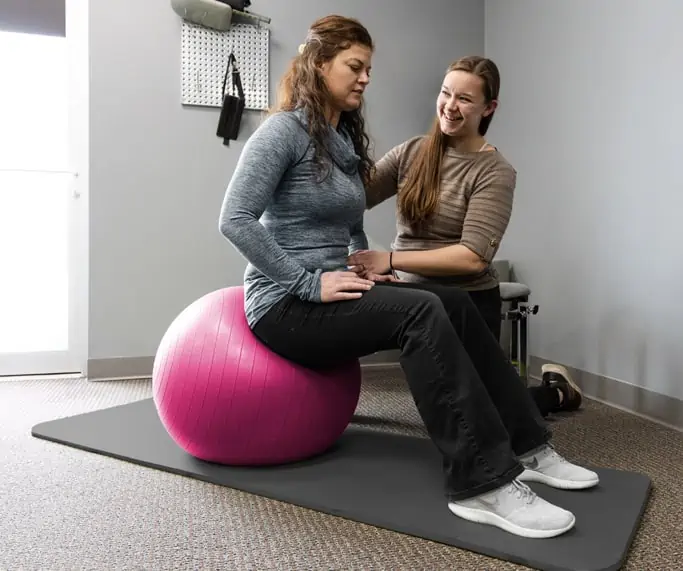
We offer an innovative approach to women's health physical therapy in a peaceful, supportive environment—that's designed by women for women.


Dr. Carolyn Nielsen
PhysioPoint is now offering Physical Therapy for Women’s Health as we welcome Dr. Carolyn Nielsen to our staff.
Millions of women suffer from one or more pelvic floor disorders, including things like:
- Difficulty tolerating a pelvic examination
- Low back pain during pregnancy
- Weakened core strength or discomfort following delivery
- Chronic constipation
- Frequent urination
- Loss of bowel/bladder control when coughing, laughing, or sneezing
- Discomfort during or following sexual intimacy
What is the pelvic floor?
The pelvic floor is made up of muscles, ligaments, and connective tissues surrounding all the organs in the pelvis. These muscles act as the support structure keeping everything in place within your body. Normally, these muscles tighten and relax like any other muscle in your body. Pelvic floor dysfunction occurs when your body keeps tightening these muscles instead of relaxing them like it should.
Who is affected by pelvic floor disorders?
Primarily women 35 or older who have had children or who are experiencing some of the issues listed above. Studies show that the frequency of pelvic floor disorders increases with age, affecting more than 40 percent of women from 60 to 79 years of age, and about 50 percent of women 80 and older.
“Roughly One Quarter of US Women Affected by Pelvic Floor Disorders,” National Institutes of Health, www.NIH.org, September 17, 2008, https://www.nih.gov/news-events/news-releases/roughly-one-quarter-us-women-affected-pelvic-floor-disorders.
What causes pelvic floor disorders?
Pregnancy, childbirth, surgery, trauma, chronic constipation, chronic coughing, and aging can cause pelvic floor muscle tension, incoordination, and weakness. Pelvic floor physiotherapy helps recondition the pelvic floor muscles to regain normal functions.
What is pelvic floor physical therapy?
Pelvic floor physical therapy is a treatment to help address pain, weakness, and dysfunction in the pelvic floor muscles. The type of therapy prescribed will depend upon the symptoms you’re experiencing. For example, some symptoms will require relaxing and lengthening of the muscles, while others may require strengthening the muscles.
What symptoms and conditions does pelvic floor physical therapy treat?
If you have any of these symptoms, pelvic floor therapy might be right for you.
Urinary problems, such as:
- Urinary incontinence
- Urinary frequency
- Urinary urgency
- Painful urination
- Difficulty stopping or starting urinating
- Difficulty fully emptying the bladder
Bowl problems:
- Fecal incontinence
- Straining or experiencing pain during bowel movements
Unexplained pain
- Pelvic pain
- Pain in the genital area
- Rectal pain
- Pain during intercourse
When should I seek medical help?
If you are a woman who has been suffering in silence, you don’t have to spend another day in pain! It’s important to seek treatment as soon as possible to prevent symptoms from worsening.
What treatment options do you provide?
- Patient, dietary, and behavioral education
- External and internal soft tissue mobilization, myofascial and trigger point release, visceral manipulation, connective tissue manipulation, and deep tissue massage
- Appropriate strengthening exercise and muscle awareness activities
- Biofeedback, electrical stimulation, and transcutaneous electrical nerve stimulation (TENS)
- Hot and cold therapy
- Home exercise program
- Vaginal dilator program
Where can I get treatment that is personalized and discreet?
PhysioPoint is welcoming Dr. Nielsen to our staff! She is a healthcare professional devoted to providing personalized care in a comfortable and discreet environment. She will work diligently to treat and strengthen particular muscle groups that will help reduce pain, improve quality of life, and avoid more costly and invasive procedures.
What will happen at my first appointment?
At your initial examination, your therapist will assess your pelvic floor musculature; however, an assessment of your posture, breathing, abdominal musculature, as well as spine will also be performed. This is just the physical examination, prior to ever taking measurements or placing hands on you, your therapist will conduct a thorough interview with you to understand the whole picture and identify any and all dysfunctions and contributing factors.
Will therapy be hands-on?
Most physical therapy to treat pelvic floor dysfunction and pain is hands-on, which includes both internal and external therapy. Because internal physical therapy may be difficult for some people, therapists are sensitive to the needs of every individual and will not begin with internal physical therapy until you are ready.
What kinds of physical therapy techniques might be used?
Physical therapy techniques include:
- Nerve release
- Trigger point therapy
- Myofascial release, also called deep tissue massage
- Skin rolling
- Joint mobilization
- Internal techniques may include using a specialized instrument or a finger inside the vagina or rectum to provide therapy
Depending on your condition, your therapist may also suggest Kegel exercises to strengthen your muscles. Dr. Nielsen will help train you on the proper way to do Kegels.
What are you waiting for?
Take Charge of Your Health
Make an appointment today and stop living in pain!

